Commercial Law: Negligence and Contributory Negligence
VerifiedAdded on 2023/06/11
|7
|1476
|387
AI Summary
This article discusses the legal elements of negligence and contributory negligence in commercial law. It examines a case study where the defendant argued that the injuries sustained by the plaintiff had been caused due to the contributory negligence of the plaintiff. The court of appeal held that the appellant was majorly responsible as he was in the position to prevent the accident and should not have encouraged the respondent to engage in such an activity. The article also discusses relevant legislation and cases.
Contribute Materials
Your contribution can guide someone’s learning journey. Share your
documents today.
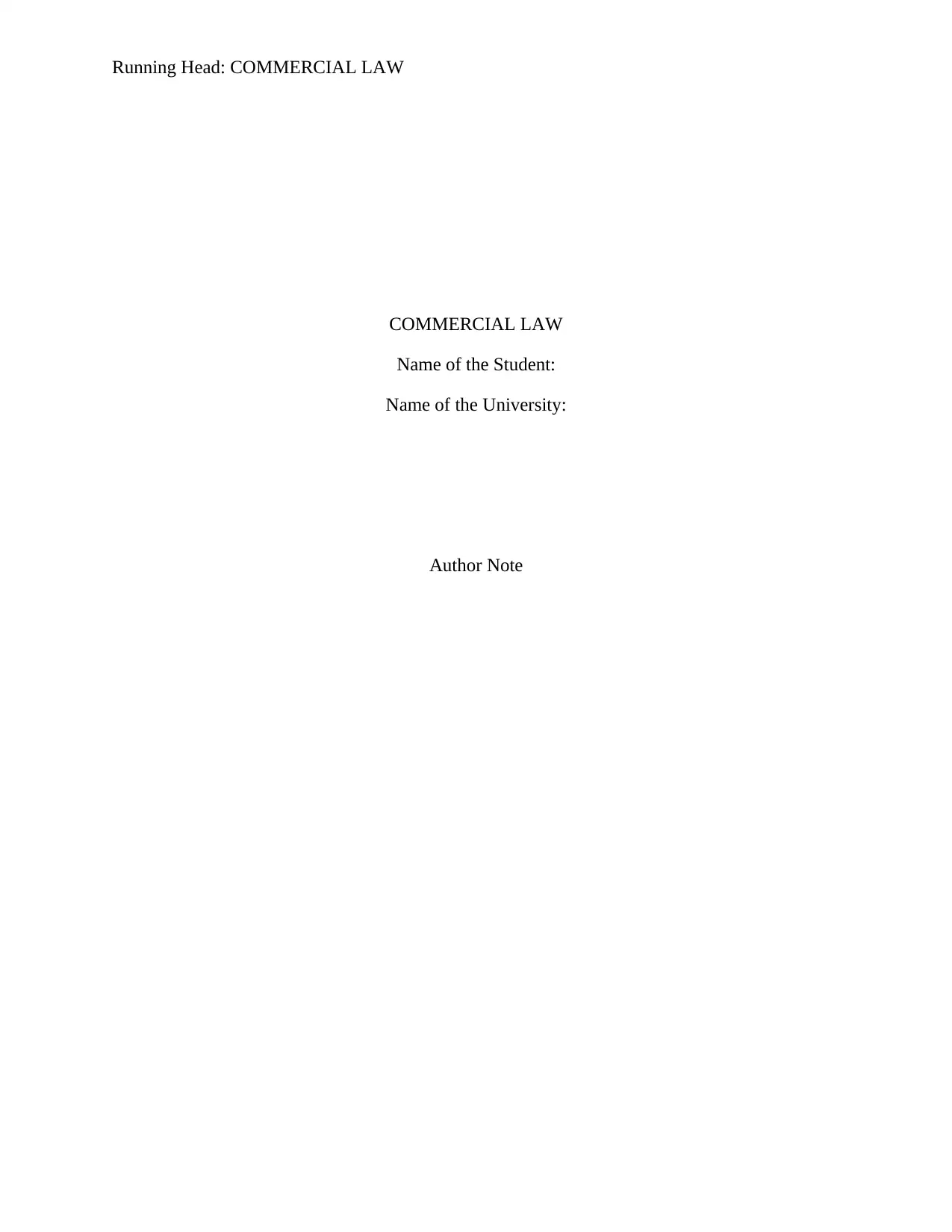
Running Head: COMMERCIAL LAW
COMMERCIAL LAW
Name of the Student:
Name of the University:
Author Note
COMMERCIAL LAW
Name of the Student:
Name of the University:
Author Note
Secure Best Marks with AI Grader
Need help grading? Try our AI Grader for instant feedback on your assignments.
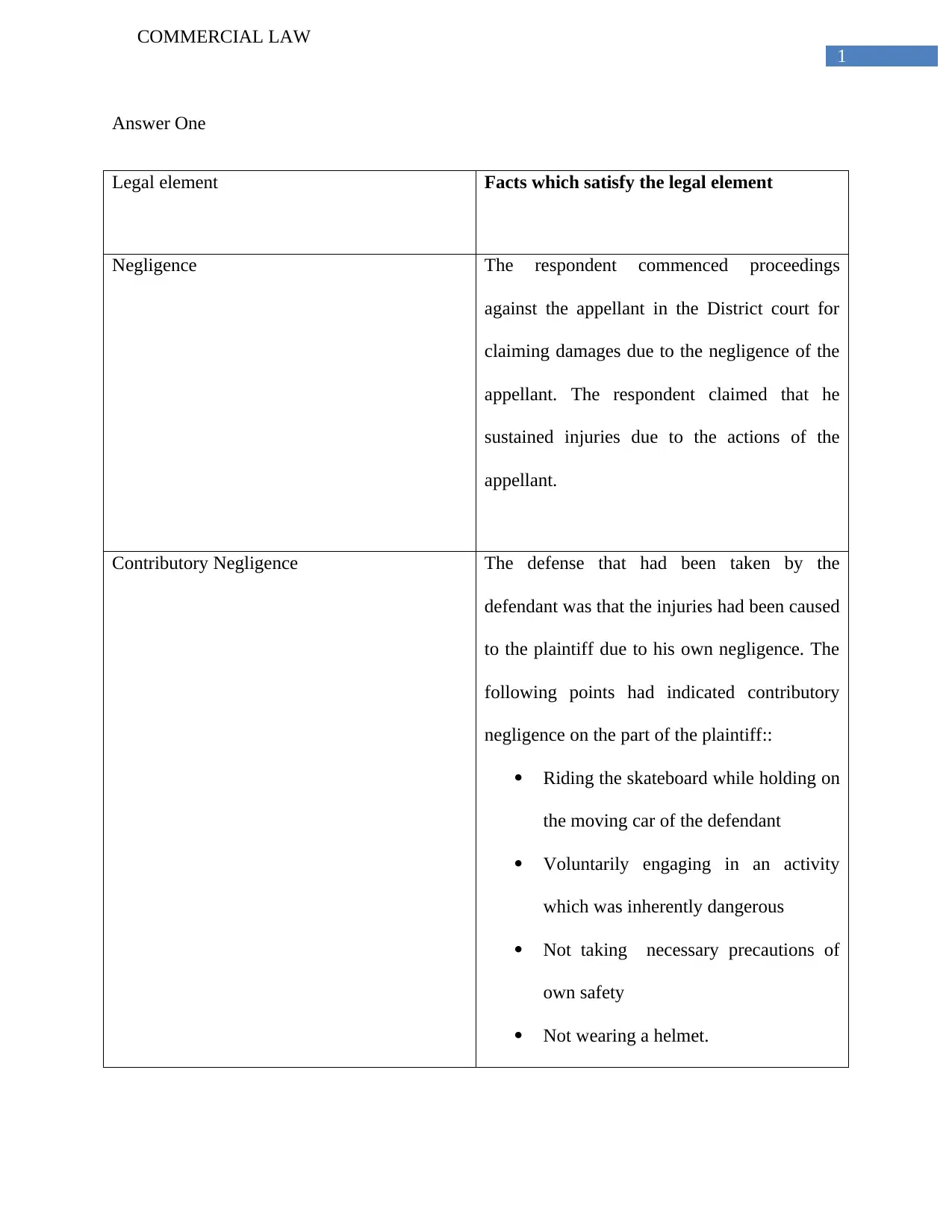
1
COMMERCIAL LAW
Answer One
Legal element Facts which satisfy the legal element
Negligence The respondent commenced proceedings
against the appellant in the District court for
claiming damages due to the negligence of the
appellant. The respondent claimed that he
sustained injuries due to the actions of the
appellant.
Contributory Negligence The defense that had been taken by the
defendant was that the injuries had been caused
to the plaintiff due to his own negligence. The
following points had indicated contributory
negligence on the part of the plaintiff::
Riding the skateboard while holding on
the moving car of the defendant
Voluntarily engaging in an activity
which was inherently dangerous
Not taking necessary precautions of
own safety
Not wearing a helmet.
COMMERCIAL LAW
Answer One
Legal element Facts which satisfy the legal element
Negligence The respondent commenced proceedings
against the appellant in the District court for
claiming damages due to the negligence of the
appellant. The respondent claimed that he
sustained injuries due to the actions of the
appellant.
Contributory Negligence The defense that had been taken by the
defendant was that the injuries had been caused
to the plaintiff due to his own negligence. The
following points had indicated contributory
negligence on the part of the plaintiff::
Riding the skateboard while holding on
the moving car of the defendant
Voluntarily engaging in an activity
which was inherently dangerous
Not taking necessary precautions of
own safety
Not wearing a helmet.
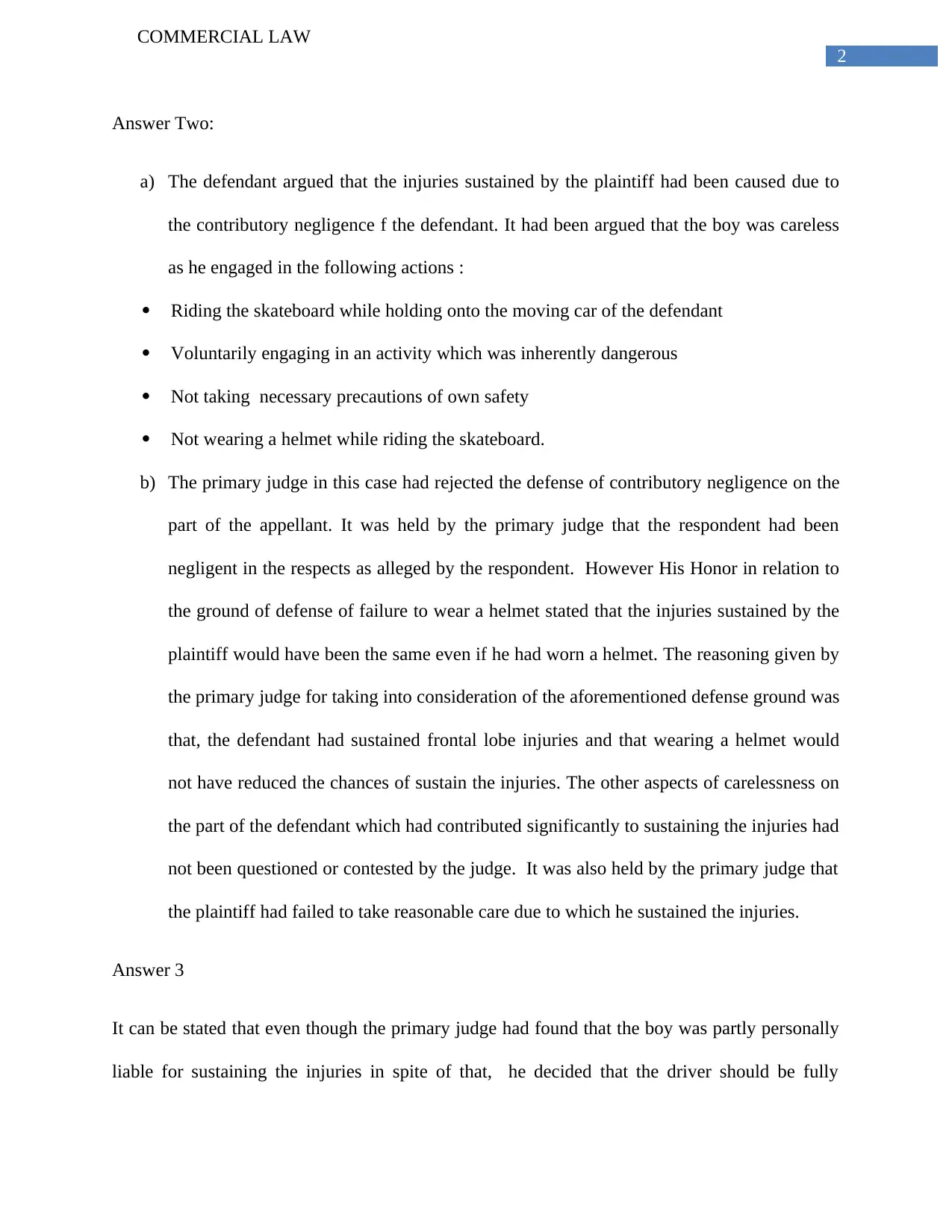
2
COMMERCIAL LAW
Answer Two:
a) The defendant argued that the injuries sustained by the plaintiff had been caused due to
the contributory negligence f the defendant. It had been argued that the boy was careless
as he engaged in the following actions :
Riding the skateboard while holding onto the moving car of the defendant
Voluntarily engaging in an activity which was inherently dangerous
Not taking necessary precautions of own safety
Not wearing a helmet while riding the skateboard.
b) The primary judge in this case had rejected the defense of contributory negligence on the
part of the appellant. It was held by the primary judge that the respondent had been
negligent in the respects as alleged by the respondent. However His Honor in relation to
the ground of defense of failure to wear a helmet stated that the injuries sustained by the
plaintiff would have been the same even if he had worn a helmet. The reasoning given by
the primary judge for taking into consideration of the aforementioned defense ground was
that, the defendant had sustained frontal lobe injuries and that wearing a helmet would
not have reduced the chances of sustain the injuries. The other aspects of carelessness on
the part of the defendant which had contributed significantly to sustaining the injuries had
not been questioned or contested by the judge. It was also held by the primary judge that
the plaintiff had failed to take reasonable care due to which he sustained the injuries.
Answer 3
It can be stated that even though the primary judge had found that the boy was partly personally
liable for sustaining the injuries in spite of that, he decided that the driver should be fully
COMMERCIAL LAW
Answer Two:
a) The defendant argued that the injuries sustained by the plaintiff had been caused due to
the contributory negligence f the defendant. It had been argued that the boy was careless
as he engaged in the following actions :
Riding the skateboard while holding onto the moving car of the defendant
Voluntarily engaging in an activity which was inherently dangerous
Not taking necessary precautions of own safety
Not wearing a helmet while riding the skateboard.
b) The primary judge in this case had rejected the defense of contributory negligence on the
part of the appellant. It was held by the primary judge that the respondent had been
negligent in the respects as alleged by the respondent. However His Honor in relation to
the ground of defense of failure to wear a helmet stated that the injuries sustained by the
plaintiff would have been the same even if he had worn a helmet. The reasoning given by
the primary judge for taking into consideration of the aforementioned defense ground was
that, the defendant had sustained frontal lobe injuries and that wearing a helmet would
not have reduced the chances of sustain the injuries. The other aspects of carelessness on
the part of the defendant which had contributed significantly to sustaining the injuries had
not been questioned or contested by the judge. It was also held by the primary judge that
the plaintiff had failed to take reasonable care due to which he sustained the injuries.
Answer 3
It can be stated that even though the primary judge had found that the boy was partly personally
liable for sustaining the injuries in spite of that, he decided that the driver should be fully
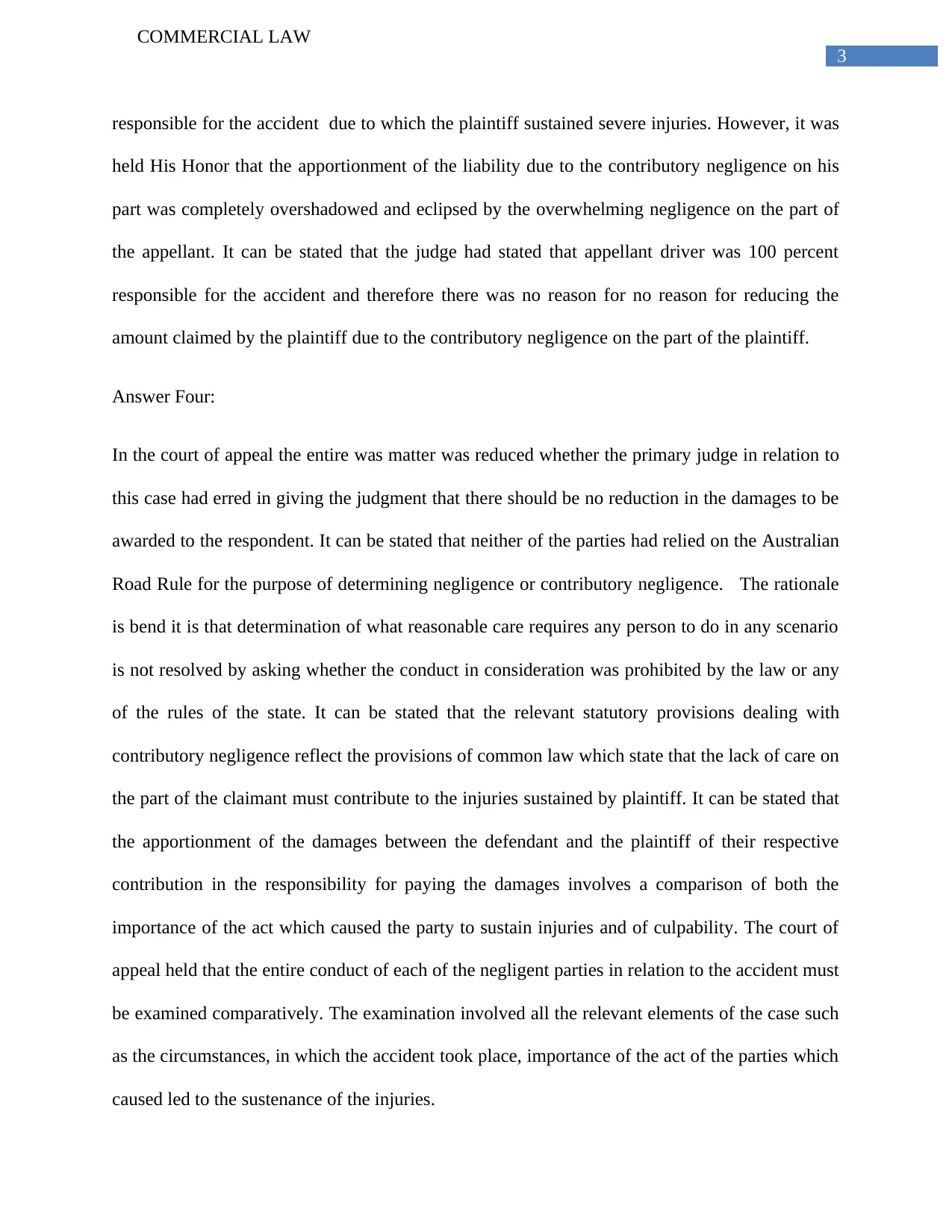
3
COMMERCIAL LAW
responsible for the accident due to which the plaintiff sustained severe injuries. However, it was
held His Honor that the apportionment of the liability due to the contributory negligence on his
part was completely overshadowed and eclipsed by the overwhelming negligence on the part of
the appellant. It can be stated that the judge had stated that appellant driver was 100 percent
responsible for the accident and therefore there was no reason for no reason for reducing the
amount claimed by the plaintiff due to the contributory negligence on the part of the plaintiff.
Answer Four:
In the court of appeal the entire was matter was reduced whether the primary judge in relation to
this case had erred in giving the judgment that there should be no reduction in the damages to be
awarded to the respondent. It can be stated that neither of the parties had relied on the Australian
Road Rule for the purpose of determining negligence or contributory negligence. The rationale
is bend it is that determination of what reasonable care requires any person to do in any scenario
is not resolved by asking whether the conduct in consideration was prohibited by the law or any
of the rules of the state. It can be stated that the relevant statutory provisions dealing with
contributory negligence reflect the provisions of common law which state that the lack of care on
the part of the claimant must contribute to the injuries sustained by plaintiff. It can be stated that
the apportionment of the damages between the defendant and the plaintiff of their respective
contribution in the responsibility for paying the damages involves a comparison of both the
importance of the act which caused the party to sustain injuries and of culpability. The court of
appeal held that the entire conduct of each of the negligent parties in relation to the accident must
be examined comparatively. The examination involved all the relevant elements of the case such
as the circumstances, in which the accident took place, importance of the act of the parties which
caused led to the sustenance of the injuries.
COMMERCIAL LAW
responsible for the accident due to which the plaintiff sustained severe injuries. However, it was
held His Honor that the apportionment of the liability due to the contributory negligence on his
part was completely overshadowed and eclipsed by the overwhelming negligence on the part of
the appellant. It can be stated that the judge had stated that appellant driver was 100 percent
responsible for the accident and therefore there was no reason for no reason for reducing the
amount claimed by the plaintiff due to the contributory negligence on the part of the plaintiff.
Answer Four:
In the court of appeal the entire was matter was reduced whether the primary judge in relation to
this case had erred in giving the judgment that there should be no reduction in the damages to be
awarded to the respondent. It can be stated that neither of the parties had relied on the Australian
Road Rule for the purpose of determining negligence or contributory negligence. The rationale
is bend it is that determination of what reasonable care requires any person to do in any scenario
is not resolved by asking whether the conduct in consideration was prohibited by the law or any
of the rules of the state. It can be stated that the relevant statutory provisions dealing with
contributory negligence reflect the provisions of common law which state that the lack of care on
the part of the claimant must contribute to the injuries sustained by plaintiff. It can be stated that
the apportionment of the damages between the defendant and the plaintiff of their respective
contribution in the responsibility for paying the damages involves a comparison of both the
importance of the act which caused the party to sustain injuries and of culpability. The court of
appeal held that the entire conduct of each of the negligent parties in relation to the accident must
be examined comparatively. The examination involved all the relevant elements of the case such
as the circumstances, in which the accident took place, importance of the act of the parties which
caused led to the sustenance of the injuries.
Secure Best Marks with AI Grader
Need help grading? Try our AI Grader for instant feedback on your assignments.
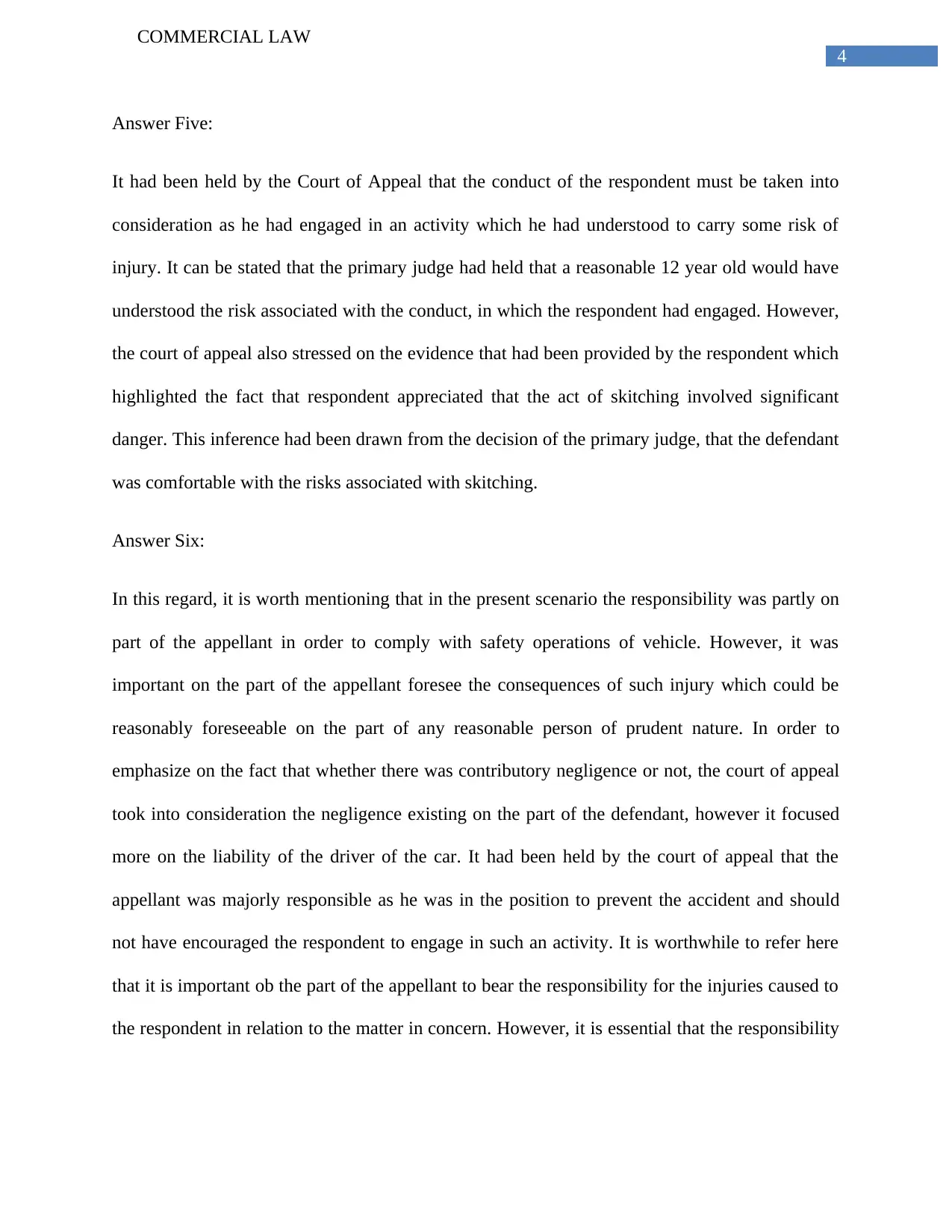
4
COMMERCIAL LAW
Answer Five:
It had been held by the Court of Appeal that the conduct of the respondent must be taken into
consideration as he had engaged in an activity which he had understood to carry some risk of
injury. It can be stated that the primary judge had held that a reasonable 12 year old would have
understood the risk associated with the conduct, in which the respondent had engaged. However,
the court of appeal also stressed on the evidence that had been provided by the respondent which
highlighted the fact that respondent appreciated that the act of skitching involved significant
danger. This inference had been drawn from the decision of the primary judge, that the defendant
was comfortable with the risks associated with skitching.
Answer Six:
In this regard, it is worth mentioning that in the present scenario the responsibility was partly on
part of the appellant in order to comply with safety operations of vehicle. However, it was
important on the part of the appellant foresee the consequences of such injury which could be
reasonably foreseeable on the part of any reasonable person of prudent nature. In order to
emphasize on the fact that whether there was contributory negligence or not, the court of appeal
took into consideration the negligence existing on the part of the defendant, however it focused
more on the liability of the driver of the car. It had been held by the court of appeal that the
appellant was majorly responsible as he was in the position to prevent the accident and should
not have encouraged the respondent to engage in such an activity. It is worthwhile to refer here
that it is important ob the part of the appellant to bear the responsibility for the injuries caused to
the respondent in relation to the matter in concern. However, it is essential that the responsibility
COMMERCIAL LAW
Answer Five:
It had been held by the Court of Appeal that the conduct of the respondent must be taken into
consideration as he had engaged in an activity which he had understood to carry some risk of
injury. It can be stated that the primary judge had held that a reasonable 12 year old would have
understood the risk associated with the conduct, in which the respondent had engaged. However,
the court of appeal also stressed on the evidence that had been provided by the respondent which
highlighted the fact that respondent appreciated that the act of skitching involved significant
danger. This inference had been drawn from the decision of the primary judge, that the defendant
was comfortable with the risks associated with skitching.
Answer Six:
In this regard, it is worth mentioning that in the present scenario the responsibility was partly on
part of the appellant in order to comply with safety operations of vehicle. However, it was
important on the part of the appellant foresee the consequences of such injury which could be
reasonably foreseeable on the part of any reasonable person of prudent nature. In order to
emphasize on the fact that whether there was contributory negligence or not, the court of appeal
took into consideration the negligence existing on the part of the defendant, however it focused
more on the liability of the driver of the car. It had been held by the court of appeal that the
appellant was majorly responsible as he was in the position to prevent the accident and should
not have encouraged the respondent to engage in such an activity. It is worthwhile to refer here
that it is important ob the part of the appellant to bear the responsibility for the injuries caused to
the respondent in relation to the matter in concern. However, it is essential that the responsibility
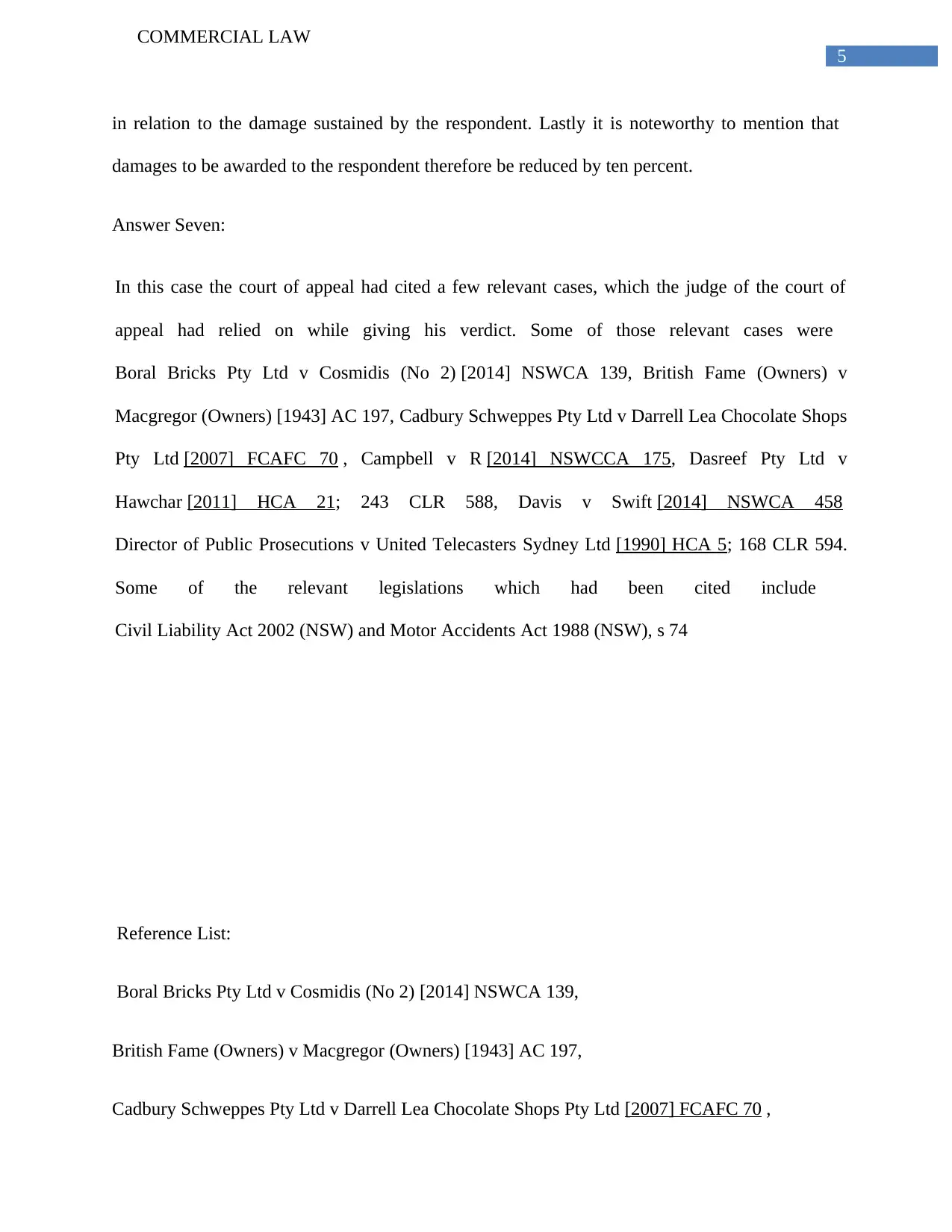
5
COMMERCIAL LAW
in relation to the damage sustained by the respondent. Lastly it is noteworthy to mention that
damages to be awarded to the respondent therefore be reduced by ten percent.
Answer Seven:
In this case the court of appeal had cited a few relevant cases, which the judge of the court of
appeal had relied on while giving his verdict. Some of those relevant cases were
Boral Bricks Pty Ltd v Cosmidis (No 2) [2014] NSWCA 139, British Fame (Owners) v
Macgregor (Owners) [1943] AC 197, Cadbury Schweppes Pty Ltd v Darrell Lea Chocolate Shops
Pty Ltd [2007] FCAFC 70 , Campbell v R [2014] NSWCCA 175, Dasreef Pty Ltd v
Hawchar [2011] HCA 21; 243 CLR 588, Davis v Swift [2014] NSWCA 458
Director of Public Prosecutions v United Telecasters Sydney Ltd [1990] HCA 5; 168 CLR 594.
Some of the relevant legislations which had been cited include
Civil Liability Act 2002 (NSW) and Motor Accidents Act 1988 (NSW), s 74
Reference List:
Boral Bricks Pty Ltd v Cosmidis (No 2) [2014] NSWCA 139,
British Fame (Owners) v Macgregor (Owners) [1943] AC 197,
Cadbury Schweppes Pty Ltd v Darrell Lea Chocolate Shops Pty Ltd [2007] FCAFC 70 ,
COMMERCIAL LAW
in relation to the damage sustained by the respondent. Lastly it is noteworthy to mention that
damages to be awarded to the respondent therefore be reduced by ten percent.
Answer Seven:
In this case the court of appeal had cited a few relevant cases, which the judge of the court of
appeal had relied on while giving his verdict. Some of those relevant cases were
Boral Bricks Pty Ltd v Cosmidis (No 2) [2014] NSWCA 139, British Fame (Owners) v
Macgregor (Owners) [1943] AC 197, Cadbury Schweppes Pty Ltd v Darrell Lea Chocolate Shops
Pty Ltd [2007] FCAFC 70 , Campbell v R [2014] NSWCCA 175, Dasreef Pty Ltd v
Hawchar [2011] HCA 21; 243 CLR 588, Davis v Swift [2014] NSWCA 458
Director of Public Prosecutions v United Telecasters Sydney Ltd [1990] HCA 5; 168 CLR 594.
Some of the relevant legislations which had been cited include
Civil Liability Act 2002 (NSW) and Motor Accidents Act 1988 (NSW), s 74
Reference List:
Boral Bricks Pty Ltd v Cosmidis (No 2) [2014] NSWCA 139,
British Fame (Owners) v Macgregor (Owners) [1943] AC 197,
Cadbury Schweppes Pty Ltd v Darrell Lea Chocolate Shops Pty Ltd [2007] FCAFC 70 ,
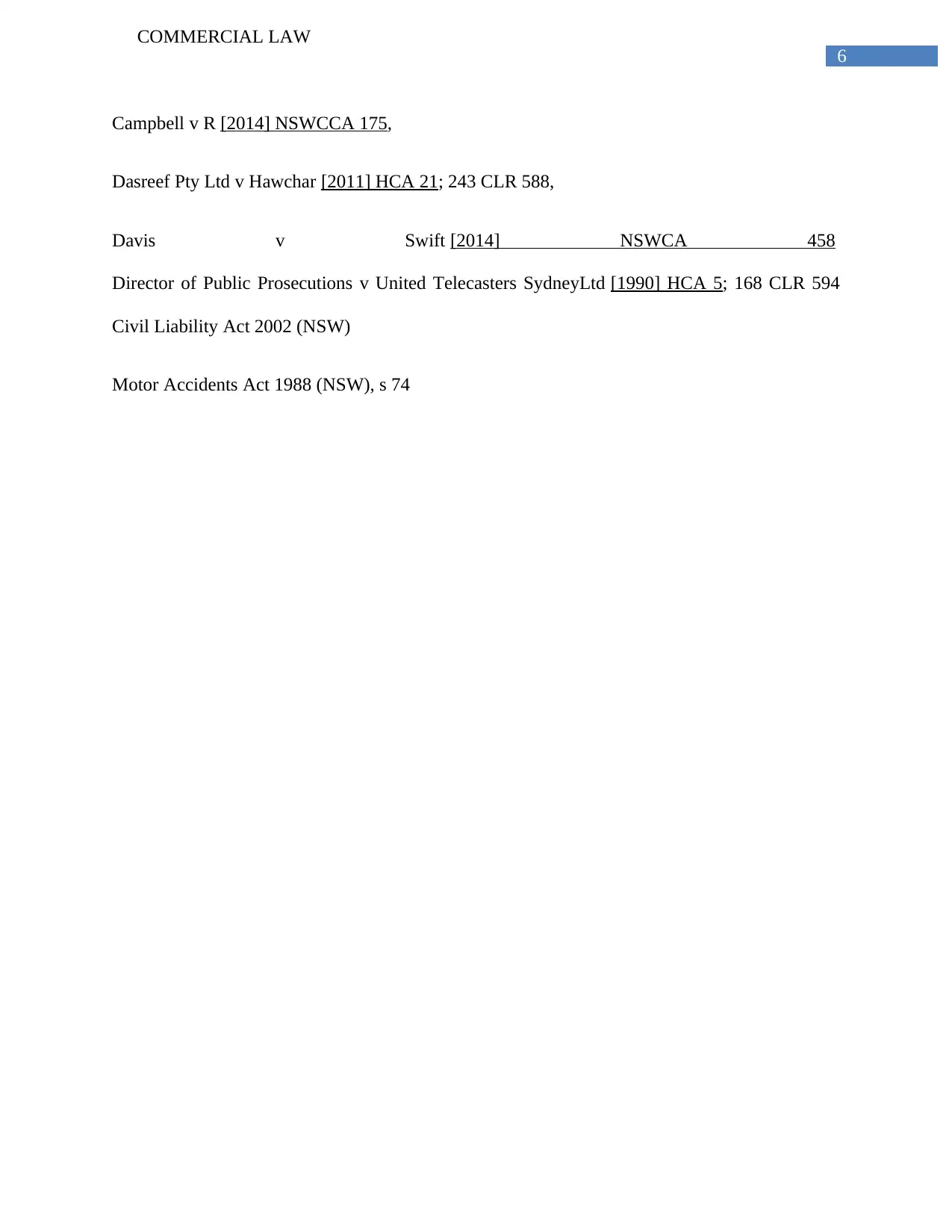
6
COMMERCIAL LAW
Campbell v R [2014] NSWCCA 175,
Dasreef Pty Ltd v Hawchar [2011] HCA 21; 243 CLR 588,
Davis v Swift [2014] NSWCA 458
Director of Public Prosecutions v United Telecasters SydneyLtd [1990] HCA 5; 168 CLR 594
Civil Liability Act 2002 (NSW)
Motor Accidents Act 1988 (NSW), s 74
COMMERCIAL LAW
Campbell v R [2014] NSWCCA 175,
Dasreef Pty Ltd v Hawchar [2011] HCA 21; 243 CLR 588,
Davis v Swift [2014] NSWCA 458
Director of Public Prosecutions v United Telecasters SydneyLtd [1990] HCA 5; 168 CLR 594
Civil Liability Act 2002 (NSW)
Motor Accidents Act 1988 (NSW), s 74
1 out of 7
Related Documents
Your All-in-One AI-Powered Toolkit for Academic Success.
+13062052269
info@desklib.com
Available 24*7 on WhatsApp / Email
![[object Object]](/_next/static/media/star-bottom.7253800d.svg)
Unlock your academic potential
© 2024 | Zucol Services PVT LTD | All rights reserved.




